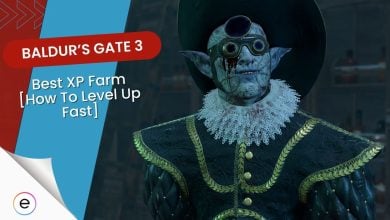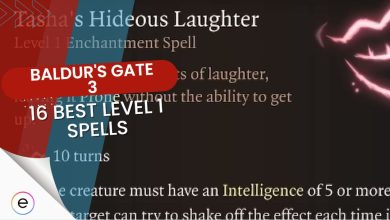Baldur’s Gate 3 offers a variety of endings based on the decisions you’ve made during your playthrough. These outcomes stem from the choices you’ve taken in companion quests, your romantic interests, and critical decisions leading up to the game’s conclusion. In my guide, I delve into the details of a number of BG3 endings witnessed in the universe.
- Baldur’s Gate 3 boasts an astonishing 17,000 possible ending variations, enhancing replayability significantly.
- Players’ interactions with companions, alignment, actions, and choices intricately shape the unfolding narrative.
- Following the defeat of the Netherbrain, players must choose between a good or bad ending.
- Opting for a good ending in BG3 results in the Netherbrain’s destruction, Mind Flayers’ defeat, and a heartfelt farewell scene.
- The bad ending in Baldur’s Gate 3 involves seizing control of the Netherbrain, leading to the manipulation of the characters’ minds.
How Many Endings Does BG3 Have?

As mentioned, Baldur’s Gate is poised to offer a staggering 17,000 ending variations upon release. It’s important to clarify that these aren’t all distinct main story conclusions. Nevertheless, given the extensive range of possibilities, it’s reasonable to anticipate an entirely new and invigorating experience when embarking on a fresh series of campaigns with a different protagonist.
Let’s delve into some of the factors below that wield influence over the endings in Baldur’s Gate:
- Companions: The party members accompanying you on your journey wield the power to steer the story in diverse directions.
- Character Alignment: Did the central character embody traits of virtue, malevolence, or perhaps a balance between the two?
- Character Actions: Both your proactive and passive choices weave into the fabric of your playthrough’s storyline.
- Character Choices: Every decision you make throughout a single playthrough exerts a tangible impact on the unfolding narrative.
Important Choice: Being Good Or Going Bad
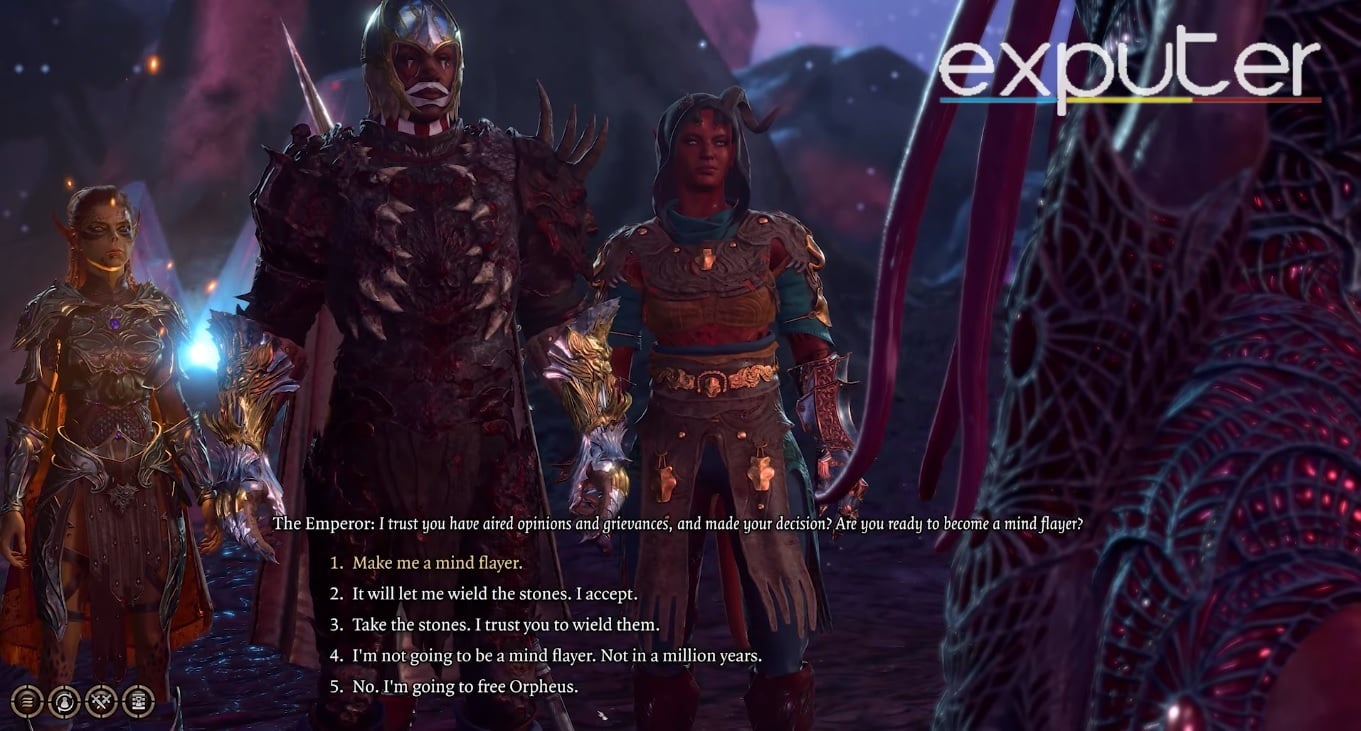
After beating the Netherbrain in the last fight, you’ve got a big decision about what to do with the Crown of Karsus:
- Good Ending – Tell the Netherbrain to destroy itself and the Illithid tadpoles.
- Bad Ending – Take control of the Netherbrain and become the Absolute, but keep in mind the bad choice might let you stab and kill your Illithid friend.
Decide if you want to wreck or control the Netherbrain.
The Good Path: Good Ending
In one of BG3’s good endings, the Netherbrain crashes into the sea and blows up. With the Mind Flayers messed up, the townspeople fight back and wipe them out. Your whole group gathers by the harbor, saying goodbye and looking forward to new stuff as the sun sets.
The Evil Path: Bad Ending
In the sinister finale of Baldur’s Gate 3, your character needs to seize dominion over the Netherbrain to become the Absolute. This might also involve taking down a Mind Flayer comrade (like the Emperor, Orpheus, or even Karlach). Your group is left astounded by your actions, but you quickly exert control over their minds too.
Main BG3 Endings
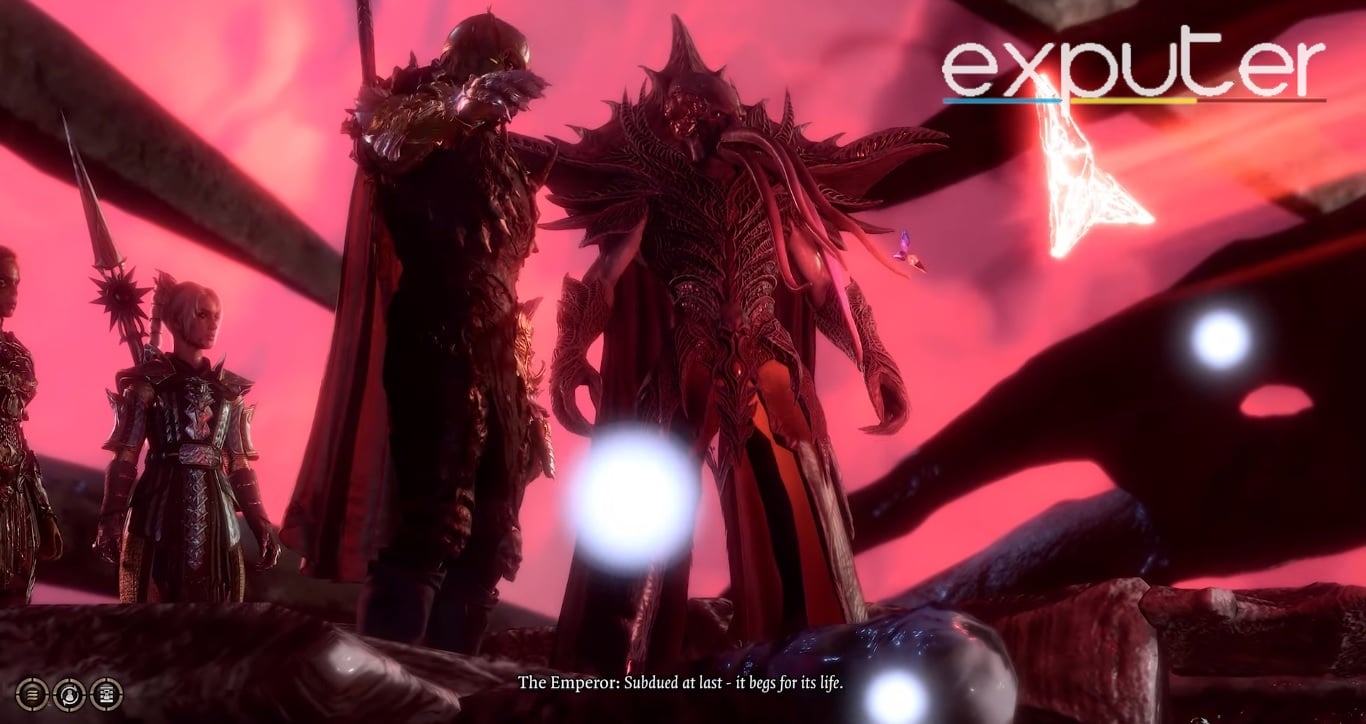
Both of the aforementioned endings have a bit more detail if you’re playing as a Dark Urge character. Also, there are several ways you can reach these endings. Following the skill checks when you initially confront the Netherbrain, the Emperor will bring you into the Astral Prism and request the Netherstones from you.
Your choice here won’t alter the ending option mentioned earlier, except for one case, yet it will define the tone of your ending and lead to various character outcomes.
Placing Your Trust In The Emperor
When you hand over the Netherstones to the Emperor and allow him to absorb Orpheus’ power, a distinct ending path unfolds. This journey involves battling your way alongside the Emperor to reach the Netherbrain.
After emerging victorious and having the Emperor subdue the Netherbrain, you’re presented with a pivotal choice: permit him to eradicate it or ruthlessly seize control of the brain by stabbing him. This conclusion results in Orpheus’ demise and the continued rule of Vlaakith over the Githyanki.
Embracing The Mind Flayer Essence
Choosing to undergo Ceremorphosis as offered by the Emperor, you consume Orpheus to transform. In the final stretch, you engage as a multiclass Mind Flayer combined with your previous class. Upon defeating the brain, the choice emerges: whether to assert control or eliminate it.
Notably, this ending boasts additional scenes post-conclusion, allowing you to chart your path now that you bear the telltale tentacles. Among the choices is the option to conclude your own life. Crucially, this avenue is available regardless of whether you align with the Emperor or liberate Orpheus.
Allowing Karlach’s Transformation Into A Mind Flayer
Karlach undergoes the transformation into a Mind Flayer and consumes Orpheus. If Karlach is a part of your party when the Emperor discusses the necessity for someone to become a Mind Flayer, she offers herself for the role. Upon selecting dialogue option three following her proposal, a brief opportunity arises to converse with her about this decision.
- Interestingly, you can pursue this route even if you are free, Orpheus.
- You just have to simply select Karlach and engage in a conversation with him, considering that you’ll be speaking through her.
- By accepting the transition into a Mind Flayer, you can potentially safeguard both Karlach and Orpheus.
Given Karlach’s eventual fate of succumbing to death from engine overheating (unless Wyll becomes the Blade of Avernus as a result of his quest), this presents an avenue to preserve both their lives. If you opt for this path, there’s no ultimate choice to betray the Mind Flayer version of Karlach, thereby committing to the favorable ending.
Freeing Orpheus
To reach this ending, secure the Orphic Hammer from Raphael. In Act 3, I achieved this by:
- Stealing from the House of Hope.
- Striking a deal at Sharess’ Caress.
This choice affects the Emperor’s allegiance; he joins Netherbrain, leading to a final showdown. Shatter crystals with the hammer. Orpheus reveals a Mind Flayer is needed to conquer Netherbrain—you, Karlach, or Orpheus. The latter asks you to end his life.
Possible Outcomes If Orpheus Dies
- Fulfill Orpheus’ request.
- Convince him to observe the Githyanki from afar.
- He ends his life.
Possible Outcomes If Orpheus Lives
- You, Karlach, or Mind Flayer Orpheus faces Vlaakith.
- Lae’zel goes or stays based on your transformation.
- Liberate Orpheus, then eliminate him for a unique end.
Character Endings In BG3
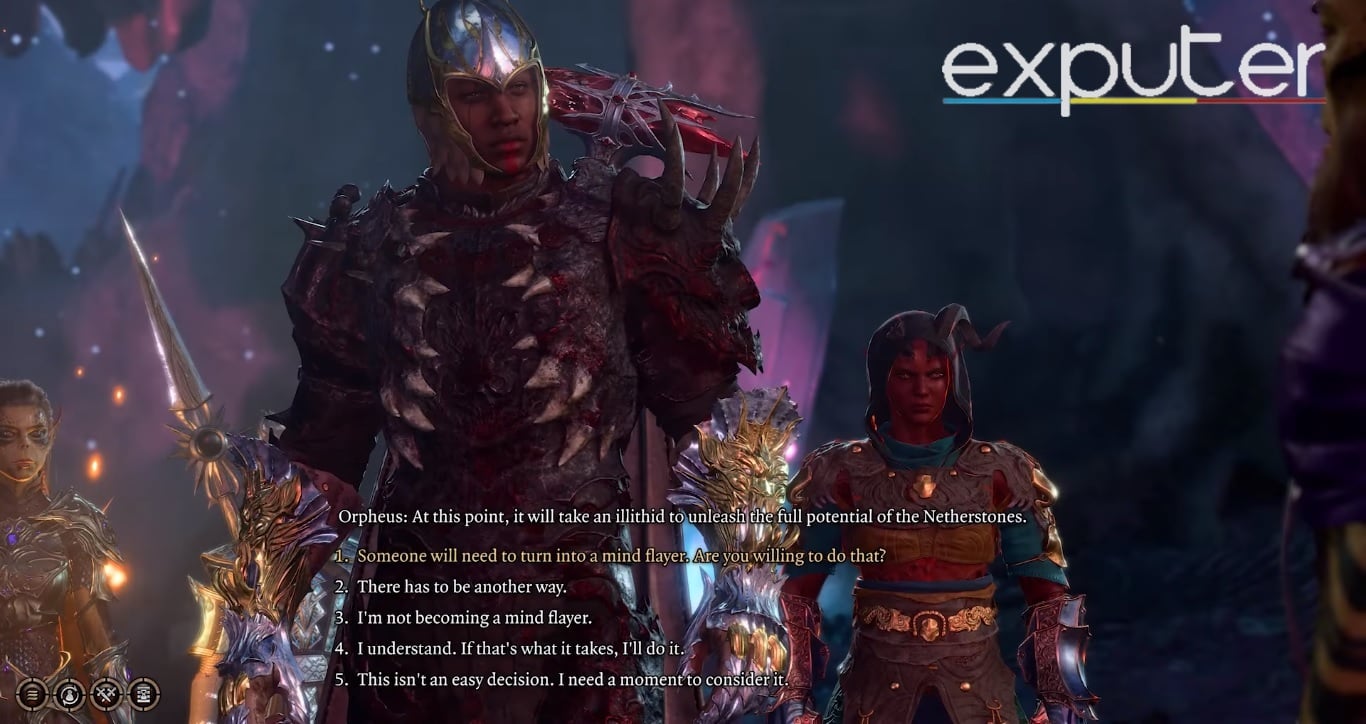
The Emperor
During the Free Orpheus path, liberating the Githyanki prince incites the Emperor’s allegiance to the Netherbrain. In the final battle, you confront and eliminate him alongside his Dream Guardians.
Lae’zel and Orpheus
In the Free Orpheus scenario, choosing to convert Orpheus into a Mind Flayer takes precedence. Alternatively, another party member (your character or Karlach) can assume the role, enabling Orpheus to remain a Githyanki.
- If Orpheus assumes Mind Flayer form, he entrusts Lae’zel with controlling his dragons to lead the Githyanki uprising against his mother, Vlaakith.
- Orpheus asks for mercy through a death sentence with his sword, as he can no longer rejoin his people as an Illithid.
- If Lae’zel concurs, you can opt to slay or convince Orpheus to endure, witnessing the Githyanki’s ascent.
- Alternatively, you can persuade Lae’zel to forge her own path.
- Orpheus is left without a choice, ultimately taking his own life.
- Mind Flayer Orpheus prefers Lae’zel to steer the rebellion, but she can follow her own way.
Gale
An alternative path to conclude Baldur’s Gate 3 emerges during Act 2’s latter half if you’ve followed Gale’s quest, nourished him with magical artifacts and encountered Eliminster Aumar at the Mountain Pass. In this sequence, Mystra assigns Gale the mission to employ the magical orb within him to destroy the heart of the Absolute—or, in this instance, the brain.
- Upon your arrival at the Mind Flayer Colony and your first encounter with the brain alongside Ketheric, Orin, and Gortash, you possess the option to allow Gale to self-detonate.
- This results in a mutual demise, thereby executing the ending.
- This ending, however, lacks optimism, with the narrator noting that the remaining Mind Flayer tadpoles ultimately seize control, casting a pall over your dramatic exit.
Moreover, irrespective of Gale’s sacrifice through the “chest bomb,” his presence in the ending remains intact. He inquires about the fate of the Crown of Karsus, presenting you with choices: delivering it to Mystra, harnessing it for personal empowerment, or leaving it to obscurity.
Astarion
Astarion’s ending involves a brief scene where he is suddenly scorched by sunlight. He hurriedly departs, with a companion observing that this marks his final exposure to sunlight. Though not confirmed, this may relate to events in Cazador’s Dungeon.
In your playthrough, you should advise Astarion against considering the ritual to become a Vampire Ascendant, possibly causing his weakness. Alternatively, this could stem from the eradication of everyone’s brain tadpoles.
Karlach And Wyll: Unveiling Their Endings
Karlach’s role in the Baldur’s Gate 3 conclusion holds significant weight. In your journey, though not in a romantic association with Karlach, you have to make some amends to her Infernal Engine. Unfortunately, its instability persists, and she is conscious of her impending demise. Her alternative entails a return to the hells of Avernus.
Furthermore, you can accomplish Wyll’s narrative arc as:
- Embrace Mizora’s proposition—that is, aiding in locating Wyll’s father in exchange for claiming Wyll’s soul.
- Rescue Duke Ravengard from the submerged prison successfully, along with discovering Wyrmway’s secret.
- Upon returning to camp, a choice materializes for Wyll: ascend as Baldur’s Gate’s next duke or assume the mantle of the Blade of Avernus.
As the Blade of Avernus, Wyll proposes to Karlach that she reunite with the hells. He vows to safeguard her from Zariel’s influence every step of the journey.
Romantic Partner: Shadowheart
Conclude your affectionate involvement with Shadowheart, who became your character’s partner. This results in a concluding scene unfolding. This outcome intertwines with choices made during the Gauntlet of Shar, Nightsong encounter, and the House of Grief. The path I took for this decision is as follows:
- Spare Nightsong and lead Shadowheart to reject Shar’s influence, committing herself to Selune.
- Inside the House of Grief, you should persuade her to safeguard her parents despite Shar’s curse.
- As the narrative draws to a close, Shadowheart expresses her intention to establish a dwelling for her parents.
- She earnestly requests your character’s companionship by her side.
Withers’ Outcome
Following the succession of scenes, a remarkable sequence unfolds featuring Withers, who openly ridicules the Dead Three—Bane, Bhaal, and Myrkul. He goes on to acknowledge that these godly figures might have underestimated his vigilance towards their schemes. The enigma of Withers persists, yet he undeniably has a prolonged history of combat against these godlike entities.
Raphael’s Path
The Deal with the Devil proposition involves the exchange of the Orphic Hammer for the Crown of Karsus. Alternatively, you can obtain the Orphic Hammer through thievery within the House of Hope and engage Raphael in a battle resulting in his demise.
Each companion’s journey concludes with distinct outcomes, encapsulating their growth and impact on the story. Whether you’re sealing your fate with the enigmatic Emperor, embracing the Mind Flayer essence, or steering the destiny of Karlach and Wyll, Baldur’s Gate 3 rewarded my choices with nuanced and diverse endings.
While you’re here, check out some BG3 Ritual Spells to diversify your character and team. Alternatively, you can even explore other intriguing in-game locations, like the Underdark region.
Next Up:
- Baldur’s Gate 3: BEST Builds
- Baldur’s Gate 3: Best Classes Tier List
- Baldur’s Gate 3: BEST Magic Items
- Baldur’s Gate 3: All Romance Options
Thanks! Do share your feedback with us. ⚡
How can we make this post better? Your help would be appreciated. ✍
 Fact Checked By
Fact Checked By 